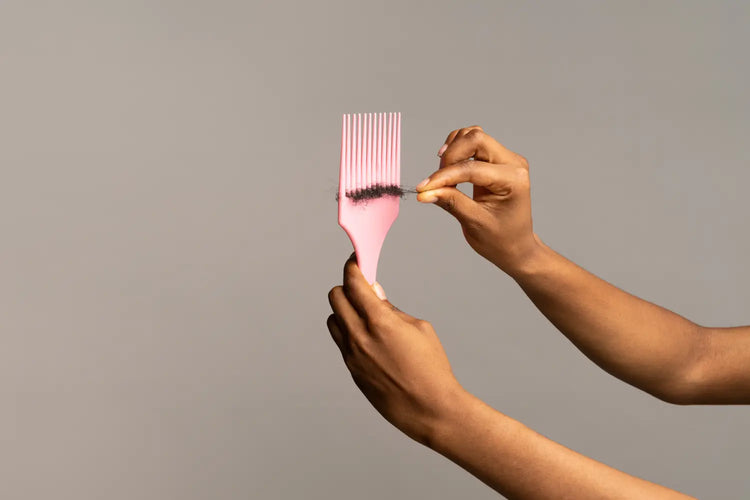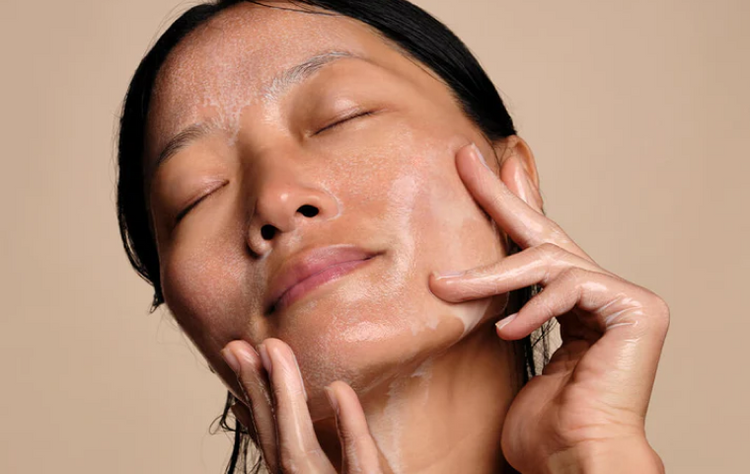COVID-19 has become such a part of our lives over the past few years, and although perhaps the worst of the pandemic has thankfully passed, it leaves a lasting imprint. One of the ways it continues to affect our lives is through long COVID — the symptoms that can linger long after you recover from your initial infection.
So while we can all be grateful that we recovered from COVID safely… it can feel like a pyrrhic victory when you start to find clumps of hair on your pillow or in your shower.
If you're noticing this unwelcome change, know you're part of a larger collective navigating COVID-related hair loss. Let’s talk about the connection between COVID-19 and hair loss, whether or not it’s a permanent change, and what you can do to help promote flowing, full, and healthy hair after this troubling experience.
What Is the Connection Between COVID-19 and Hair Health?
While most discussions around COVID-19 focus on acute symptoms experienced during infection, there’s more and more research being done on the aftereffects of COVID-19. So-called “long COVID” potentially comes with a range of symptoms, one of which is escalating cases of hair loss.
This likely happens because, during an infection, your body focuses its energy on essential functions to ensure you recover. This can happen at the expense of hair follicles — because, in the grand scheme of things, they’re not a life-or-death function of your body, although it can feel like it when they’re not working as you’d expect.
This energetic shift causes a domino effect, pushing more hair into the shedding phase. While we’re going to talk more about what you can do to cope with and address this, it might be helpful to remember that your COVID hair loss is a survival mechanism. It’s a sign that your body fought and won, and so there’s something to be said for honoring your body for everything it does for you, even when you’re not feeling your best.
What Is Telogen Effluvium?
While we don’t need to unpack all of the scientific terms around this type of hair loss, there’s one phrase that you’ll likely see again and again in your frantic googling: “telogen effluvium.” Telogen effluvium refers to a form of hair loss often initiated by a stressor, setting it apart from conditions like alopecia areata or androgenetic alopecia.
Your hair exists in a life cycle with distinct phases — anagen, catagen, and telogen. Normally, a minuscule percentage of your hair is in the telogen or "resting" phase. A significant event like COVID-19 can push more strands into this phase, leading to a noticeable shedding.
Now, for the silver lining: acute telogen effluvium is generally a transient affair. As your body heals and the stressor dissipates, your hair often resumes its natural cycle. It's a testament to your body's innate resilience and ability to recalibrate. So take heart … Your luscious locks are more likely on a sabbatical than a permanent leave.
How Does the Hair Growth Cycle Work?
Hair doesn't grow randomly — it adheres to a well-orchestrated cycle composed of three distinct phases: the anagen, or growth phase; the catagen, or transitional phase; and the telogen, or shedding phase. Each phase plays a vital role in the lifecycle of a hair strand, and when this equilibrium is unsettled, that's when you start seeing handfuls of hair during combing or in the shower.
In the anagen phase, the hair follicles are busy creating new hair. This stage can last for years, fostering long, healthy strands. The catagen phase is more of a short interlude, lasting only a few weeks. During this phase, the hair follicle shrinks and detaches from the dermal papilla, preparing the strand for eventual shedding. Finally, in the telogen phase, your hair takes a well-earned break. After a few months of inactivity, these hairs get replaced by new ones in the anagen phase, and the cycle continues.
Events like a COVID-19 infection or emotional stress serve as stressors that can shove more hair from the anagen and catagen phases into the telogen phase before their time. This can result in a sudden increase in shedding, often diagnosed as acute telogen effluvium.
You'll notice excessive hair falling out, which can be disconcerting, to say the least. But here’s the positive spin: this process is often reversible!
When Does Hair Regrowth Start After COVID?
Most individuals experience signs of regrowth within a timeframe of three to six months after recovering from a COVID-19 infection. What's more, chronic telogen effluvium, or long-lasting hair loss, has a lower prevalence rate when compared to its acute counterpart.
This points to a temporary nature of the condition rather than an endless ordeal. Even for those unfortunate few who experience "long COVID," and by extension, longer periods of hair loss, there are prescription treatments available if you visit a dermatologist or doctor, such as minoxidil, which can encourage faster regrowth. Regardless of the longevity of this side effect, there are things you can do at home to help support healthy hair.
Keep in mind that patience is crucial in this journey back to full hair health. Your body has just fought off a formidable virus, and readjusting takes time. Give yourself, and your hair, the grace period needed for a robust comeback.
How Can You Support Your Hair and Scalp After COVID?
Taking proactive steps to nurture your scalp and hair can be a transformative experience during times of COVID-related hair loss. While there are few things that will result in an instantaneous fix for your hair concerns, taking some simple steps to promote the well-being of your scalp and stimulate hair growth can be very helpful.
1. Reduce the Stress on Your Scalp
When it comes to mitigating hair loss, especially after a stressful event like COVID-19, being kind to your scalp is paramount. Choose hairstyles that keep the stress off your follicles. Loose braids and casual ponytails aren't just trendy, they're also follicle-friendly.
In the same way that you need to take a rest day from workouts occasionally to let your body recover, think of this as an opportunity to give your follicles a much-needed rest day to recover.
Gentle combing is crucial as well. The use of soft-bristled brushes minimizes mechanical stress and breakage on delicate, recovering hair strands. The act of combing shouldn't just detangle but also treat your hair with the tender care it needs in a vulnerable state.
2. Manage Your Own Stress Levels
Emotional stress can catalyze hormonal imbalances that may wreak havoc on your hair follicles. Techniques such as mindfulness meditation or deep-breathing exercises can be remarkably effective, and in general, looking for ways to promote self-care and peacefulness within yourself is a good way to improve your life in more ways than just your hair quality.
By nourishing your emotional health, you're creating a more favorable environment for hair growth, reinforcing your follicles against stress-induced shedding.
3. Practice Scalp Gua Sha Massages
Scalp massages can promote growth, and since a massage and scraping technique called Gua Sha is also known for its rejuvenating properties, incorporating scalp massages into your daily routine may help to promote healthy hair growth.
For those keen on integrating cutting-edge wellness tools into their routine, the Empress Gua Sha Stimulating Scalp Comb is your go-to gadget. It’s a blend of ancient wisdom and contemporary design, meticulously crafted to amplify circulation and placate the scalp. Fashioned from high-grade Bian stone, this comb is a powerhouse of over forty healing minerals.
The stone’s origins trace back to a meteor striking Earth 65 million years ago, giving it unique properties like ultrasound pulsation and far-infrared wave emission. These features provide both antioxidant and anti-aging benefits. In essence, this specialized comb energizes your scalp, laying the foundation for healthy, lush hair.
4. Find Products That Help Detox Your Scalp
Before you even reach for your Empress Gua Sha Scalp Comb, prep your scalp with Empress Balm of Gilead Barrier Repair Oil. This phytonutrient-dense facial oil functions like liquid Gua Sha, designed to animate and condition the scalp. Active botanicals are infused for two months to unleash the full spectrum of their vitamins, minerals, and antioxidants.
Sunstone, instilled under the full moon's light, suffuses the oil with a luminous energy. The incorporation of hand-harvested Balm of Gilead resin amplifies its skin barrier restoration, collagen stimulation, and microcirculation enhancement. Finally, our Resin Nutrient Complex delivers an extra boost, designed to even out skin tones. This multi-functional oil offers a thorough scalp detox, setting you up for a successful hair regrowth journey.
Let’s Not Split Hairs
Navigating the labyrinth of COVID-related hair loss can be a daunting task, but we’ll say it once more: it’s a sign of your body’s strength and resilience… and if that isn’t comforting enough, it’s more than likely temporary.
That said, when armed with the right tools like those in our Empress collection, coupled with appropriate lifestyle shifts, you can potentially kickstart regrowth and restore your locks to their former glory. At the end of the day, your well-being is not just skin or scalp-deep. It’s a harmonic blend of your physical, emotional, and cosmic energies.
Sources:
Losing Your Hair After Covid-19? There Is Good News | University of Utah
Can Covid-19 Cause Hair Loss | American Academy of Dermatology

